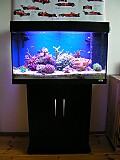
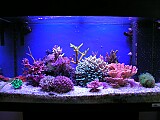
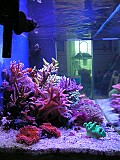
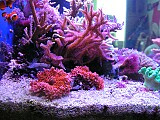
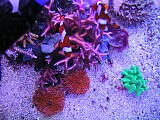
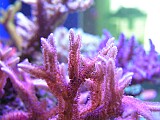
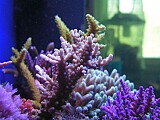


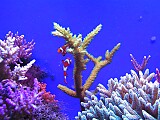

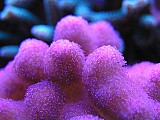
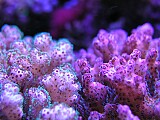
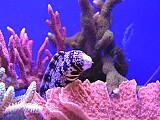
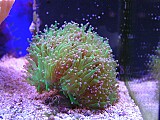
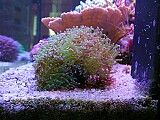

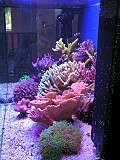


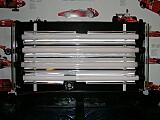
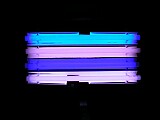
Started 2/2006, Photos 8/2006, Tapio's Nano was here
Tapio's mini reef is run with the same simple method as was his nano reef. With this method it is possible to keep and grow even colourful sps corals in a small reef aquarium. The colours and the growth rate in our mini and nano have been almost the same as they are in my main aquarium. Water remains chrystal clear, nitrates and phosphates are nearzero, and the maintenance is minimal. There has been a slow growth of various macroalgae species and no harmful microalgae growth. Several zooplankton species multiply in our nano and they are eaten by clown fishes. This is simply the best method to keep succesful mini or nano reef aquarium.
Technical equipment:
1) Aquarium
Juwel® 120 l glass aquarium 80cm x 35cm x 43cm with a stand.
2) Filter and water flow
Juwel® aquarium has integrated inside filter. This filter is filled with filter materials descriped below. Additional water flow is achieved with Maxi-Jet 1000 l/h pump equiped with Hydor FLO rotating water deflector. These pumps and rotating water deflector provide very good changing water flow in the tank.
3) Light
Four 18w normal output fluorescent tubes are used. Two of the tubes are blue (Arcadia Marine Blue and Osram 67) and two are daylight (Arcadia Marine White and Hagen PowerGlo) tubes. They are driven by a single 2 x 54 w electric ballast. This gives you adequate light intensity to grow even colourful sps corals. I wouldn't use metal halide lights in mini or nano reefs. With fluorescent tubes you get much even and softer illumination of the tank and less heat problems. Beside the tubes there is a fan directed to water surface to provide adequate gas exchange in the tank and to keep the temperature at about 24-28 centigrades.
4) Reverse osmosis or deionisation unit
You need good quality water to make saltwater changes and to compensate evaporation with fresh water. Aqualight AL1 di unit is an excellent choice and a cheap one if you have only mini or nano reef.
This can really be all the technical equipment you need. The protein skimmer is totally unnecessary. In the tank we have 5cm of coral sand (0-2mm) in the bottom. It is better if you get some live sand from matured tanks. There is only about 8 kg live rock in the tank.
The heart of this system is in the filter. In the lowest chamber there is Seachem denitrate in passive circulation (water can flow passing it). We have used about 0.5l in our filter. Seachem denitrate has high porosity to support both aerobic and anaerobic bacteria and it removes nitrates, nitrites and organics from water. You should exchange denitrate if the nitrates start to rise. In the upper chamber there is good quality coarse activated carbon like Eheim Ehvi Aktiv and coarse iron based phosphate remover like Korellen-zucht Biophos 2. They are in active circulation placed in the sparse filter bags so that the water runs freely through them. We used about 1 dl carbon and 1 dl Biophos in our filter. We change them every 1-2 months.
We compensate evaporation by pouring about 1l fresh water every day to the aquarium. In the fresh water we mix about 1 tablespoon of CaCl2 or 1 tablespoon of NaHCO3 alternately to keep Calcium and KH in the nano in natural levels. Ca and KH values are controlled every 1-2 weeks and necessary adjustments are then made. We will automate Ca, KH and fresh water additions in near future. Also three drops of Korallen-zucht Aminoacid Concentration and one drop of Lugol's solution is added at the same time.
10% water change is done every week using Tropic Marin Pro Reef or hw Meersalz Professional, the salinity is kept at 35 ppt.
The fish are fed daily with a little flake or frozen food.